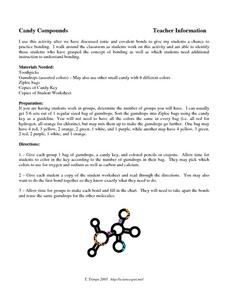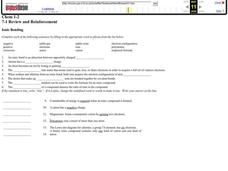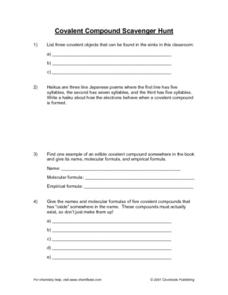Curated OER
AP Chemistry Chapter 9
In this AP Chemistry worksheet, students apply concepts of electron configuration to accurately answer the questions provided. Students also draw Lewis structures of the given elements. Students estimate the enthalpy of formation as well...
Curated OER
Hybridization
In this chemical compounds worksheet, students draw the Lewis structure and "cloud" structures for given compounds. Then students match the Lewis structure with the correct cloud diagrams. This worksheet has 2 problems to solve.
Curated OER
Predicting Molecular Shapes
In this molecular shapes worksheet, students read about how to predict molecular shapes in molecules based on the number of electron pairs and the VSEPR theory. Students are given twelve molecules, they draw the Lewis structures and...
Curated OER
2005 U.S. National Chemistry Olympiad - Local Section Exam
National Chemistry Olympiad tests are released after their use each year, since they cannot use them again for this event. The result: outstanding comprehensive assessment resources for general chemistry classes! This 2005 version covers...
Curated OER
Bonding Basics - Ionic Bonds
In this chemistry worksheet, students complete the chart for each of the listed elements, including the number of protons, electrons, and valence electrons. Then they complete each of the ionic bonds that follows.
Curated OER
Covalent Bonding - Electron Dot Structures
A short paragraph helps explain how covalent bonds are formed, and then your class will complete the Electron/Dot and Structural diagrams for the molecules given. The valence diagrams will reinforce understanding. This activity...
Curated OER
Predicting Molecular Geometry and Hybridization
In this molecular geometry and hybridization learning exercise, students identify bond angles, Lewis structures, hybridization, polarity and valance electrons in given molecules. They also label a drawn compound with hybridization and...
Curated OER
Chemistry 1A Review
For this Chemistry 1A worksheet, learners review, molecular weight, solubility, endothermic reactions, and number of protons, neutrons, and electrons for elements. Students review Lewis Structures and how to predict the amount of product...
Curated OER
Hybridization and Valence Bond Theory
In this chemistry activity, students use knowledge of valance bonds in order to answer the in depth application of science problems.
Curated OER
Bonding Basics - Covalent Bonds
For this chemistry worksheet, students complete the chart for each of the given elements by naming the number of protons, electrons, Valence electrons, and the electrons used to fill the outer shell. Then they complete each covalent bond...
Curated OER
Organic Chemistry Problem Set Exam 1
Though there are technically only 13 questions on this exam, they take up six pages and make a thorough assessment of organic chemistry principles. There are plenty of diagrams to label or complete. Emission spectra are displayed for...
Curated OER
How Do Atoms Stick Together?
In this chemical bonding learning exercise, students answer 76 questions about compounds, Lewis dot structures, intermolecular forces between atoms, electronegativity and bonding and types of bonds.
Curated OER
Candy Compounds
In this compounds worksheet, students are given a bag of colored gumdrops that represent specific atoms. They construct ionic and covalent bonds with gumdrops using the key provided and the compounds to build. They fill in a chart with...
Curated OER
Creating Bonds
In this creating bonds worksheet, students create 2-D and 3-D models of the molecular formula provided. Students complete a chart of information about the molecular formula given.
Curated OER
Ionic Bonding
In this ionic bonding worksheet, high schoolers review the characteristics of ionic bonding, draw Lewis dot diagrams for elements, and write the chemical formula for ionic compounds. This worksheet has 8 drawings, 14 fill in the blank,...
Curated OER
VSEPR And Polarity
In this VSEPR theory worksheet, students evaluate the electron-pair geometry of organic and inorganic molecules. They construct Lewis structures and resonance structures for 17 compounds and complete 3 short answer questions.
Curated OER
Intermolecular Forces
In this compounds instructional activity, students identify the main intermolecular force in the given compounds and explain the differences between dipole-dipole forces and hydrogen bonds. This instructional activity has 5 short answer...
Curated OER
Biochemistry Assignment
In this biochemistry worksheet, students complete a table by filling in the missing information about different elements. Students draw the Bohr diagram and the Lewis dot diagram for several atoms.
Curated OER
Intermolecular Forces Worksheet
In this intermolecular forces worksheet, high schoolers answer 4 questions about the forces between atoms within molecules and compounds. Students rank the boiling points of compounds based on their intermolecular forces and they explain...
Curated OER
Metals vs. Non-Metals
In this elements worksheet, students compare and contrast the characteristics of metals and non-metals. Students practice drawing Lewis dot diagrams and writing ion notation. This worksheet has 9 word problems, 8 matching questions, and...
Curated OER
IPC Chemistry Review
In this chemistry review worksheet, students classify and name compounds, calculate atomic mass, draw Lewis Dot Diagrams, and determine number of protons for atoms. This worksheet has 37 fill in the blank, 38 matching, and 3 short answer...
Curated OER
Compounds
In this compounds activity, students draw the Lewis dot structure for given compounds plus determine the electron geometry, type of hybrid, molecular geometry, polarity, and number of sigma and pi bonds. This activity has 5 fill in the...
Curated OER
Covalent Compound Scavenger Hunt
For this chemistry worksheet, students look for the covalent compounds while examining the objects in the classroom. They also apply the knowledge of formulas.
Curated OER
Formulas
There are two sheets here, with 100 problems total. The first half is a list of compounds, and your young chemists should write the chemical formula for each. The next fifty give the formula and the name is required. You...























